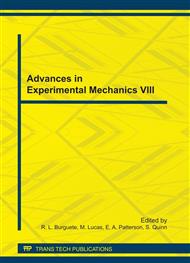[1]
F. Feyel, Multiscale FE2 elastoviscoplastic analysis of composite structures, Computational Materials Science, 16: 344–354, (1999).
DOI: 10.1016/s0927-0256(99)00077-4
Google Scholar
[2]
V. Kouznetsova, M. Geers, W. Brekelmans, Multi-scale constitutive modelling of heterogeneous materials with a gradient-enhanced computational homogenization scheme, International Journal for Numerical Methods in Engineering, 54: 1235–1260, (2002).
DOI: 10.1002/nme.541
Google Scholar
[3]
C. Miehe, A. Koch, Computational micro-to-macro transitions of discretised microstructures undergoing small strains, Archive of Applied Mechanics, 72: 300–317, (2002).
DOI: 10.1007/s00419-002-0212-2
Google Scholar
[4]
Ł. Kaczmarczyk, C.J. Pearce, N. Bićanić, Scale transition and enforcement of RVE boundary conditions in second-order computational homogenization, International Journal for Numerical Methods in Engineering, 74: 506–522, (2008).
DOI: 10.1002/nme.2188
Google Scholar
[5]
Ł. Kaczmarczyk, C.J. Pearce, N. Bićanić, Studies of microstructural size effect and higher-order deformation in second-order computational homogenization, Computers and Structures, (2008).
DOI: 10.1016/j.compstruc.2008.08.004
Google Scholar
[6]
T. Belytschko, S. Loehnert, J.H. Song, Multiscale aggregating discontinuities: A method for circumventing loss of material stability, International Journal for Numerical Methods in Engineering, 73: 869–894, (2008).
DOI: 10.1002/nme.2156
Google Scholar
[7]
I. Gitman, H. Askes, L. Sluys, Coupled-volume multi-scale modelling of quasi brittle material, European Journal of Mechanics A/Solids, 27: 302–327, (2008).
DOI: 10.1016/j.euromechsol.2007.10.004
Google Scholar
[8]
C. Miehe, C. Bayreuther, On multiscale FE analyses of heterogeneous structures: from homogenization to multigrid solvers, International Journal for Numerical Methods in Engineering, 71: 1135–1180, (2007).
DOI: 10.1002/nme.1972
Google Scholar
[9]
Ł. Kaczmarczyk, C.J. Pearce, N. Bićanić, E. de Souza Neto, Numerical multiscale solution strategy for fracturing heterogeneous materials, Computer Methods in Applied Mechanics and Engineering, 199(17-20): 1100 – 1113, (2010).
DOI: 10.1016/j.cma.2009.11.018
Google Scholar
[10]
Ł. Kaczmarczyk, C.J. Pearce, A corotational hybrid-Trefftz stress formulation for modelling cohesive cracks, Computer Methods in Applied Mechanics and Engineering, 198(15-16): 1298 – 1310, (2009).
DOI: 10.1016/j.cma.2008.11.018
Google Scholar
[11]
M.R.A. van Vliet, Size Effect in Tensile Fracture of Concrete and Rock, PhD thesis, Delft University of Technology, (2000).
Google Scholar
[12]
W. Zhu, J.J. Hughes, N. Bicanic and C.J. Pearce, Nanoindentation mapping of mechanical properties of cement paste and natural rocks, Materials Characterization, 58(11-12): 1189-1198, (2007).
DOI: 10.1016/j.matchar.2007.05.018
Google Scholar


